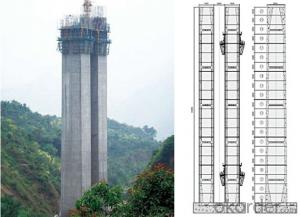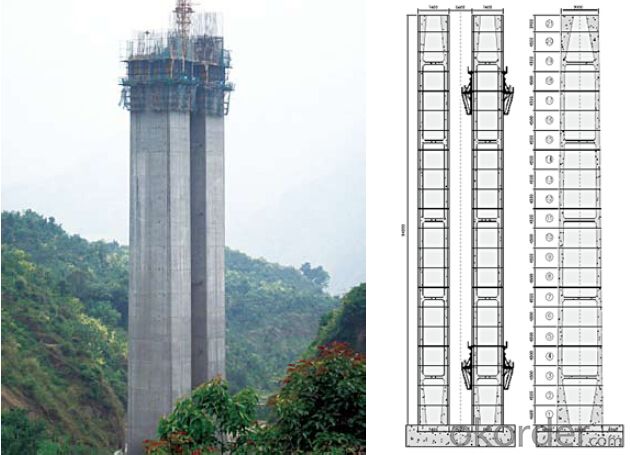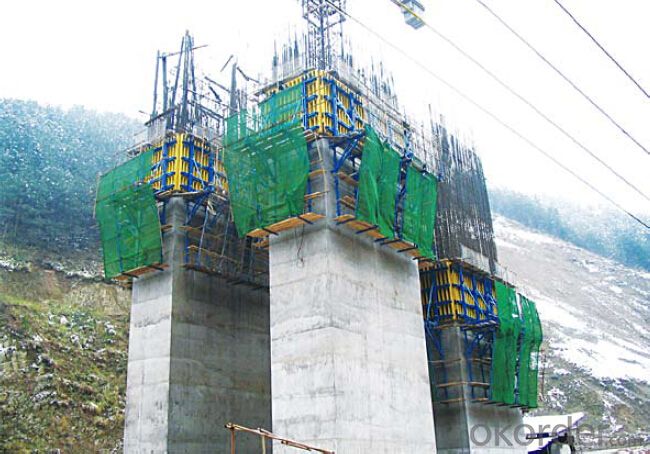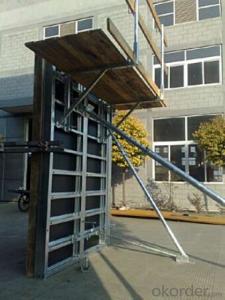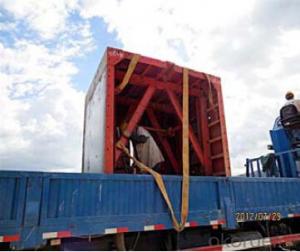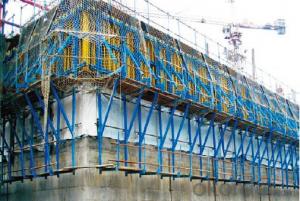Climbing Bracket CB-240 for formwork and scaffolding systems
- Loading Port:
- Tianjin
- Payment Terms:
- TT OR LC
- Min Order Qty:
- 50 m²
- Supply Capability:
- 1000 m²/month
OKorder Service Pledge
OKorder Financial Service
You Might Also Like
Climbing Bracket CB240 & CB210
They are framework brackets for supporting large-area wall formwork.
Typical applications for the CB240&CB210 are pier and column/shear wall/core walll/ in the
building.
CB210 has smaller size than CB240, it will be cost effective in some condition.
Characteristics:
◆ High bearing capacity
The high loading capacity of the brackets allow very large scaffold units. This saves the number
anchor points required as well as reducing climbing times.
◆ Simple moving procedure by crane
Through the strong connection of formwork together with the climbing scaffold, both can be moved
as a single climbing unit by crane. Thus valuable time-savings can be achieved.
◆ Fast striking process without a crane
With the retrusive set, large formwork elements can also be retracted quickly and a minimum of
effort.
◆ Safe with work platform
The platforms have assembled firmly with bracket and will be climbing together, without scaffolding
but can work safely in spite of your high location.
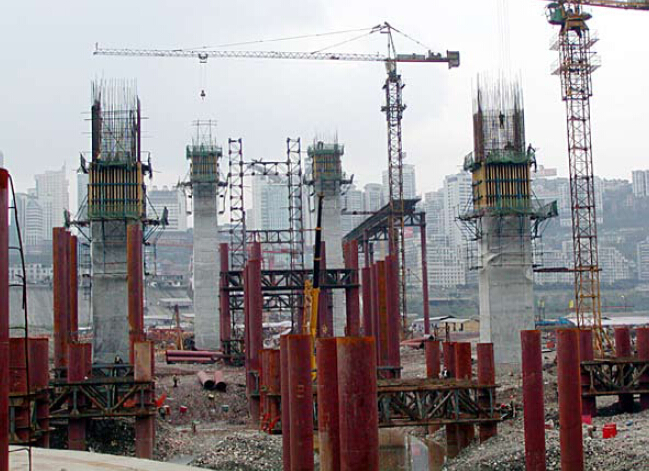
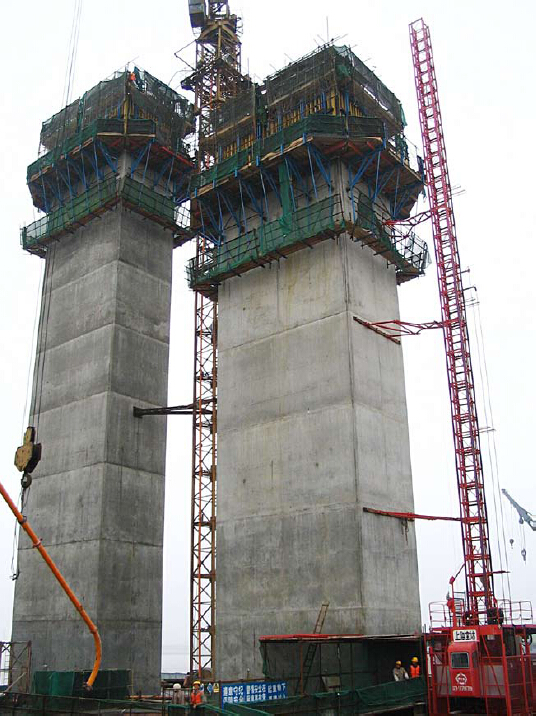
- Q: What are the considerations when designing steel formwork for columns?
- There are several important factors to consider when designing steel formwork for columns. These factors include the size and shape of the column, the load it will bear, the height of the column, the desired finish of the concrete, and the availability of labor and equipment. To begin with, the dimensions and configuration of the formwork will be determined by the size and shape of the column. The formwork must be able to accommodate the specific dimensions of the column, including its diameter or width, as well as its height. It may need to be adjustable or modular to fit different column sizes and shapes. Additionally, the ability of the formwork to withstand the weight of the concrete and any additional loads is crucial. It must be designed to support the weight without deforming or failing, ensuring the structure's integrity and safety. The height of the column is also a consideration in formwork design. Tall columns may require extra support or bracing to prevent buckling or collapsing. The formwork should be designed to provide sufficient stability and strength throughout the column's height. Furthermore, the desired finish of the concrete is an important factor to keep in mind. If a smooth or architectural finish is desired, the formwork must be designed to create a smooth and even surface. This might involve using special form liners or coatings to achieve the desired finish. Lastly, the availability of labor and equipment should be taken into account. The formwork design should consider how easy it is to assemble, disassemble, and transport. It should be practical and efficient to install and dismantle, taking into consideration the labor and equipment available on the construction site. In conclusion, when designing steel formwork for columns, it is important to consider the size and shape of the column, the load it will bear, the height of the column, the desired concrete finish, and the availability of labor and equipment. By carefully considering these factors, the formwork can be designed to meet the specific requirements of the project, ensuring a safe and efficient construction process.
- Q: How does steel formwork handle concrete pouring and consolidation?
- Steel formwork is a popular choice for concrete pouring and consolidation due to its strength, durability, and ease of use. When it comes to handling concrete pouring and consolidation, steel formwork offers several advantages. Firstly, steel formwork provides a solid and rigid structure that can withstand the pressure exerted by the weight of the concrete. This ensures that the formwork remains stable throughout the pouring and consolidation process, preventing any deformations or collapses that could compromise the quality of the concrete structure. Additionally, steel formwork is highly resistant to moisture and chemicals present in the concrete mix, which helps to maintain its integrity and durability. This resistance ensures that the formwork does not get damaged or corroded during the pouring and consolidation process, thereby prolonging its lifespan and reducing maintenance costs. Moreover, steel formwork allows for efficient and precise concrete placement and consolidation. The smooth surfaces of steel formwork facilitate the easy flow and distribution of the concrete, ensuring that it fills all the required areas evenly. This helps to eliminate voids and air pockets, resulting in a denser and more structurally sound concrete structure. Furthermore, steel formwork can be easily adjusted and customized to meet specific project requirements. Its modular nature allows for easy assembly and disassembly, making it a cost-effective choice for various construction projects. The flexibility of steel formwork also allows for the creation of complex shapes and designs, enabling architects and engineers to realize their creative visions. In conclusion, steel formwork is an ideal choice for handling concrete pouring and consolidation due to its strength, durability, and versatility. It provides a stable and robust structure that can withstand the weight and pressure of the concrete, while also ensuring efficient and precise placement and consolidation. These qualities make steel formwork a reliable and practical solution for a wide range of construction projects.
- Q: What are the common quality control measures for steel formwork systems?
- Some common quality control measures for steel formwork systems include conducting regular inspections of the formwork components for any signs of damage or wear, verifying the accuracy of dimensions and alignments, ensuring proper installation and alignment of formwork components, conducting load tests to ensure the formwork system can withstand the required loads, and monitoring the concrete pouring process to ensure proper placement and consolidation. Additionally, adherence to relevant industry standards and guidelines, as well as proper documentation and record-keeping, are also important quality control measures for steel formwork systems.
- Q: Can steel formwork be used for precast concrete tanks?
- Yes, steel formwork can be used for precast concrete tanks. Steel is a popular choice for formwork due to its strength, durability, and versatility. It provides the necessary support and shape for the concrete to be poured and cured, ensuring that the tank has the desired dimensions and structural integrity. Steel formwork can be designed and fabricated to meet the specific requirements of precast concrete tanks, allowing for precise and efficient construction. Additionally, steel formwork can be reused multiple times, making it a cost-effective solution for precast concrete tank production.
- Q: Can steel formwork be used for both small and large concrete pours?
- Yes, steel formwork can be used for both small and large concrete pours. Steel formwork is highly versatile and can be easily adjusted or modified to accommodate different sizes and shapes of concrete structures. It provides high strength and stability, making it suitable for large pours where heavy loads and pressures are involved. Additionally, steel formwork can be reused multiple times, making it a cost-effective option for both small and large construction projects.
- Q: Are there any limitations or disadvantages of using steel formwork?
- Yes, there are some limitations and disadvantages of using steel formwork. One limitation is the cost. Steel formwork is generally more expensive than other types of formwork, such as wood or aluminum. This can make it a less viable option for projects with tight budgets. Another limitation is the weight and bulkiness of steel formwork. It can be difficult to transport and handle due to its heavy weight, which may require additional equipment and labor. Additionally, the bulkiness can make it challenging to store and stack the formwork when not in use. Steel formwork also requires skilled labor for assembly and disassembly. Unlike other types of formwork, such as modular or reusable plastic formwork, steel formwork often needs to be custom-made and fitted on-site. This can increase labor costs and time required for the construction process. Furthermore, steel formwork is susceptible to corrosion if not properly maintained. Exposure to moisture, chemicals, and harsh weather conditions can lead to rusting, weakening the formwork over time. Regular inspections and maintenance are necessary to ensure the longevity and safety of steel formwork. Lastly, steel formwork may not be suitable for all types of construction projects. Its rigidity and lack of flexibility make it less adaptable to complex or irregular shapes. In such cases, other formwork materials or systems might be more suitable. Despite these limitations and disadvantages, steel formwork also offers several advantages, such as durability, reusability, and high load-bearing capacity. Therefore, it is essential to carefully consider the specific requirements of the project before deciding whether to use steel formwork.
- Q: What is the steel formwork and its construction advantages
- Stable weather. The mechanical strength is high, under the condition of the temperature of -20 DEG C to +60 DEG C, the utility model has the advantages of no shrinkage, no expansion, no cracking, no deformation, stable size, alkali resistance, corrosion resistance, fire resistance, water resistance and insect repellent.
- Q: How does steel formwork handle different concrete surface sealing products?
- Steel formwork is a widely used material in the construction industry for creating molds or structures to pour concrete into. When it comes to dealing with different sealing products for concrete surfaces, steel formwork offers certain advantages and considerations. First and foremost, steel formwork is exceptionally durable and strong, making it ideal for withstanding the application of various sealing products for concrete surfaces. These sealing products, like epoxy coatings, polyurethane sealers, or acrylic sealants, are typically designed to improve the durability, appearance, and resistance of the concrete surface. Steel formwork can handle the application process without sustaining any damage or compromise. Additionally, steel formwork provides a smooth and uniform surface for applying sealing products to concrete surfaces. This is crucial because a proper seal requires an even and consistent application to ensure optimal performance. With proper construction and maintenance, steel formwork can provide the necessary precision and flatness required for successful sealing product application. However, it is important to note that using specific sealing products for concrete surfaces may necessitate additional preparation and precautions when utilizing steel formwork. For example, if a sealing product requires a clean and porous surface to adhere properly, the steel formwork may need treatment or roughening to create the desired surface texture. Techniques like sandblasting or the application of a bonding agent can achieve this. Furthermore, before applying sealing products to concrete surfaces, it is crucial to ensure that the steel formwork is thoroughly cleaned and free from any residues or contaminants. Any remaining concrete, oils, or dirt on the formwork may interfere with the adhesion and performance of the sealing products. Regular maintenance and cleaning of the steel formwork are essential to guarantee its compatibility with various sealing products for concrete surfaces. In conclusion, steel formwork is a dependable and robust material that can handle different sealing products for concrete surfaces. Its durability, precision, and smooth surface make it a suitable choice for applying various sealing products. However, optimal compatibility and performance may require additional preparation, maintenance, and cleaning.
- Q: What are the different types of release agents used with steel formwork?
- There exist various release agents that can be utilized with steel formwork. Some of the most frequently encountered types encompass: 1. Water-based release agents: These release agents consist mainly of water, with additives like surfactants and lubricants. They are environmentally friendly and can be easily applied by spraying or brushing onto the steel formwork. By forming a thin film on the steel surface, water-based release agents prevent the concrete from adhering during the curing process. 2. Solvent-based release agents: Organic solvents serve as the carrier for the active ingredients in these release agents. They are effective in providing a smooth surface finish on the concrete and are often employed in situations where a higher level of release performance is required. Application is typically done through spraying or brushing, and the solvents evaporate quickly, leaving a thin film on the steel formwork. 3. Barrier release agents: These release agents are usually applied as a thick paste or gel, creating a physical barrier between the steel formwork and the concrete. They are commonly used when a high-quality surface finish is desired, such as in architectural concrete applications. Brushing or troweling the barrier release agents onto the steel formwork is the typical method of application. 4. Dry release agents: These agents come in powdered or granular form and are directly applied to the steel formwork. They create a non-stick surface by absorbing excess moisture from the concrete, thus preventing adhesion. Dry release agents are often employed in situations where other types of release agents may not be suitable, such as in cold weather conditions. 5. Form release oils: Petroleum-based products, known as form release oils, are frequently used in conjunction with steel formwork. They effectively establish a release barrier between the steel and the concrete, preventing adhesion. Application of form release oils is typically done through spraying or brushing, and they can be utilized in various concrete applications. The selection of the appropriate release agent is crucial and should be based on specific project requirements, including the desired surface finish, environmental considerations, and ease of application. Seeking guidance from professionals or consulting the manufacturer's recommendations can aid in determining the most suitable release agent for a particular steel formwork application.
- Q: Can steel formwork be used in areas with limited construction equipment access?
- Yes, steel formwork can be used in areas with limited construction equipment access. Steel formwork is known for its durability and strength, making it suitable for use in remote or difficult-to-access areas. Unlike other types of formwork, steel formwork does not require extensive machinery or equipment for installation. It can be easily transported and assembled manually, reducing the reliance on heavy machinery. Additionally, steel formwork is reusable, which means it can be disassembled and moved to different locations if necessary. This versatility makes steel formwork a practical choice for construction projects in areas with limited equipment access, ensuring efficient and cost-effective construction processes.
Send your message to us
Climbing Bracket CB-240 for formwork and scaffolding systems
- Loading Port:
- Tianjin
- Payment Terms:
- TT OR LC
- Min Order Qty:
- 50 m²
- Supply Capability:
- 1000 m²/month
OKorder Service Pledge
OKorder Financial Service
Similar products
Hot products
Hot Searches
